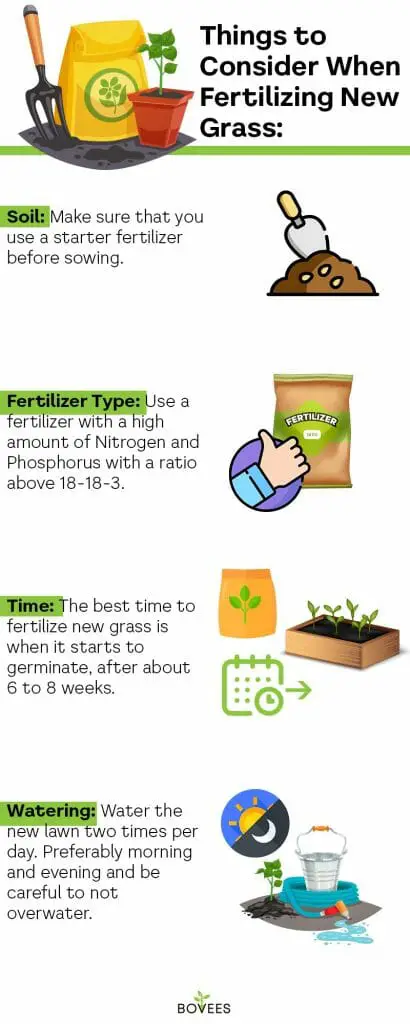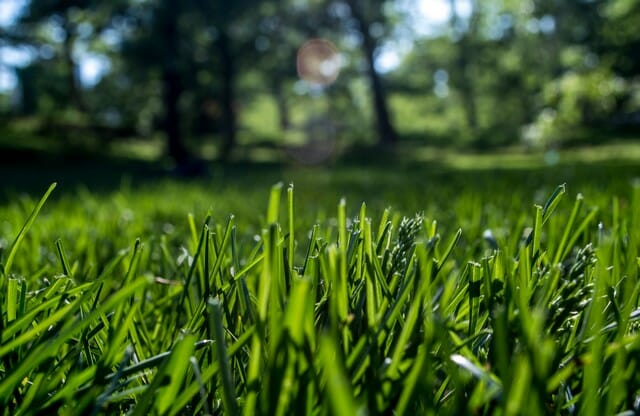Last Updated on April 18, 2022 by Grow with Bovees
When redesigning your old garden or looking for ways to improve your yellowish, patchy or damaged lawn, it is important that you choose and make use of the correct lawn fertilizer.
How does it work, and when is the correct time that you should fertilize new grass seed? Is using regular fertilizer good enough?
These are all questions that you need to have answered before going ahead with the process of using a slow release fertilizer in order to gain a lush lawn.
We answer that and more in this article. Included topics are:
- Reasons to fertilize new grass seed.
- Best types of lawn starter fertilizer.
- When should you fertilize?
- Seeding steps.
- Tips for lush grass.

Reasons for Fertilizing New Grass
Regular fertilizer consists of the most crucial nutrients that are needed when laying grass seed and growing a new lawn.
It is a crucial part of correct lawn care and will aid in maintaining a healthy lawn by promoting proper root growth.
So, applying the right fertilizer into your soil before planting seed will offer a great boost to the process.
Here are some other scenarios when a fertilizer would be useful in a lawn care routine:
- Lack of direct sun: Most lawns need four to six hours of direct sun to thrive.
- Rare watering: If you can’t often water or don’t have an automatic irrigation system, to keep the soil moist, then fertilizer might help make up for that.
- Speeding things up: It’s not a secret that fertilizers are commonly used to speed up the growth rate of plants, and a new lawn is no exception.
Avoid lawn problems: High-quality fertilizer, as opposed to regular fertilizer, makes your soil more resistant to erosion, brown patches, lawn fungus, red thread, snow mold, and summer patching.
Which Is the Best Fertilizer for New Grass?
The best fertilizer for planting grass seed and growing a new lawn should contain a high amount of nitrogen and phosphorus.
The former will make your grass lush, vibrant, and green, while the latter will help it absorb nutrients. Potassium is another key ingredient here, as it reduces the chance of disease.
We recommend Scotts Turf builder starter food as a great new grass fertilizer. Thanks to its special formula you can expect your grass to come in around 70 percent thicker, as it grows 35 percent faster, according to the company.
Scotts starter fertilizer is an excellent choice for fertilizing zoysia grass, and almost every type of grass, including new sod and grass plugs or reseeding the old ones.
More importantly, it has enough potassium to guard new grass and improve water absorption in poor soil until it grows up.
What Is a Good Lawn Starter Fertilizer for New Grass Seeds or Sod?
A good starter fertilizer for new grass seed and sod would be similar to the category above. The same fertilizer, Scotts starter, could be an appropriate option here.
What Nutrients Are in Lawn Fertilizer?
There are three primary minerals in new grass fertilizers for enhancing grass health: nitrogen, phosphorus and potassium.
On packages, you’ll notice most companies use a ratio, otherwise known as NPK. For example, a 20-5-5 ratio means 20 percent nitrogen, 5 percent phosphorus, and 5 percent potassium.
Different fertilizers will contain various ratios designed for specific uses and types of grasses.
How Do They Help New Grass?
Fertilizer provides your soil with the right minerals that make your lawn grow fast, lush and green.
The right fertilizer will improve the overall health and appearance of your lawn and will help protect it from drought and burning.
If your grass is lacking nutrients, it may not grow at all or it could turn brown. Another possible scenario is yard fungus. That might include patches of mushrooms, slimy parts, or other uninviting characteristics.
Lawn fungus can be pesky and ruin your lawn quickly, however, the good news is that with the right treatment it’s easy to overcome.
What Do Nitrogen, Phosphorus, and Potassium Actually Do?
The three crucial ingredients and primary nutrients in most fertilizers work as follows:
- Nitrogen: It’s what makes your grass thick and green, promoting leaf growth.
- Phosphorus: Triggers root growth and promotes root development, seed expansion and mineral consumption.
- Potassium: Shields grass from disease, drought and rough winters.
Furthermore, potassium supports the role of nitrogen, as it helps the plant cells absorb it over time.
What Fertilizer Ratio for Established Lawns
It’s important to understand that you have to pick the appropriate fertilizer ratio for your lawn and grass type and whether or not you have a well established lawn.
Is your lawn established? A NPK ratio of 20-5-5 could give it a little boost to maintain its quality throughout the year.
A slow-release fertilizer might be best here, as it’ll help with maintenance overall. Using this type of fertilizer on your existing grass means you shouldn’t need to fertilize more than two to three times per year.
What the Ratio of Fertilizer for a New Lawn
The best ratio for a new lawn is different. You’ll probably opt for a fast release fertilizer instead, with a ratio closer to 20-20-10.
As you’ll notice, the phosphorus level is higher here to give your new lawn a boost in growth. This potent ratio should provide your new grass with a longer protection period and a rich green color.
Best All Around Fertilizer
Scotts Turf Builder Starter Food is the all around lawn fertilizer that we consider to be the best.
This type of starter fertilizer is great to use when planting new grass seeds or laying fresh grass sod or plugs and it promises to boost your new grass to become 70% thicker and grow 35% quicker as opposed to unfed grass.
Scotts Turf Builder has a nutrient ratio of 24-25-4. This combination of nutritious material benefits developing lawns greatly and promotes the growth and development of strong roots and beautiful sturdy grass leaves.
This lovely lawn fertilizer is also safe to use on any grass type.
It does not matter whether you want to plant new grass seeds to plant a new lawn, reseed an already existing lawn, or whether you wish to install new sprigs, grass plugs or sod, Scott Turf Builder is safe to use everytime.
Apart from all the lovely benefits it has on your lawn, this product is also easy to spread across an area, easy to use and quite cost effective. Purchase it in four different sizes.
Take note, that this product does not get sold in the state of Florida.
Best Ready To Spray Fertilizer
Scotts Turf Builder Starter Food for New Grass Ready-Spray is considered to be the best ready-to-spray grass fertilizer.
This product also has the ability to boost the growth of the lawn, promoting it to become thick and green quicker than grass that does not get fed with fertilizer.
This product promises to improve seeding results by feeding and watering the lawn at the same time. It is safe to use this product on all grass types and great to use for grass plugs and sod.
It does not matter if you are starting a new lawn, reseeding an already established one or installing new sprigs or plugs. Scotts Turf Builder For New Grass Ready Spray, is incredibly easy to use and it is fast to apply the fertilizer.
Simply grab your garden hose and attach it to the fertilizer spray bottle, make sure that the activation switch it switched to on, then pointing the nozzle of the bottle at the desired area, start spraying the lawn evenly.
When you are done, slide the activation switch back to off.
Apply your first dose of this spray fertilizer when you notice the grass beginning to sprout followed by a second feeding one week later and another a week after that.
This lawn fertilizer proves to be great value for money and helps your grass to take root better.
Best Hose End Spray Fertilizer
Extreme grass growth lawn booster is a hose end spray fertilizer that is great to use on your lawn. It is produced by a greatly experienced family business, working in the commercial professional turf industry, in the United States of America.
This great hose end spray fertilizer contains nitrogen and phosphorus and is manufactured with an advanced humic acid formula which is great to increase the lateral as well as the vertical growth of an established lawn. Not only is it good to use on established lawns, but also shows great benefit when used for new seeding.
This product is purchased as a ready-to-use hose end fertilizer filled with concentrated nutrients that are ready to give your grass the boost that it needs to grow healthily.
Extreme grass growth lawn booster is a multi functional fertilizer that is not only great to use on new lawns or as a starter fertilizer, but it is also a good choice when it comes to repairing a lawn. It can be used on all grass types.
These grasses include Kentucky Bluegrass, Zoysia, Bahia, Bermuda, Ryegrass, Fescue, St.Augustine, Centipede, Buffalo and Florida Palmetto.
The phosphorus present in this product promotes seed germination which makes it highly recommended for lawn seeding. It also boosts root growth in early growth stages.
The nitrogen present in this lawn fertilizer on the other hand promotes the lawn to grow attractive and dense. This is due to the major part that it plays in the chlorophyll found on the grass leaves.
Best Extended Feeding Fertilizer
The best extended feeding fertilizer that we have come across is the Pennington UltraGreen Starter Lawn Fertilizer.
This is a great starter fertilizer to use for overseeding already existing lawns or on new lawns with sod or grass seeds.
It is a premium blend of essential nutrients mixed together in an easy to use resealable bag. It contains fast acting/quick release nitrogen and slow releasing nitrogen, promoting quick greening of the grass, as well as feeding it for up to three months, all at the same time.
Included in this blend, you will find about 5% iron, which will give your grass a beautiful and lush deep, dark green color.
This product promises a faster lawn establishment and helps to build strong roots as well as strong and thick grass leaves.
When Should I Fertilize New Grass?
The best time to fertilize new grass is around four to six weeks after the grass sprouts from the new seed.
Today, there are plenty of starter fertilizers for new grass, and most of them will be nitrogen-rich. As I mentioned above, choose an NPK ratio of 20-20-10 for new grass.
How To Fertilize New Grass Seed

Every fertilizer will have a label with clear instructions, but I’ll give you some extra tips on how to avoid common unwanted setbacks.
You should use a broadcast spreader to distribute your fertilizer after planting the grass seeds. This machine is efficient and the most popular option for home fertilizing jobs.
You could take the old school approach by sprinkling the fertilizer by-hand with a handheld spreader, but it’s more difficult to spread it evenly.
There’s a chance for accidental over-fertilization here, as well, which can lead to dead seeds, little growth and burnt bits.
10 Steps for Seeding a New Lawn
- If you have poor soil, you’ll first use a weed killer for any current vegetation. After everything dies off, collect it neatly and make sure you don’t leave any remains. Read the weed killer instructions carefully to know exactly when to seed your new lawn.
- If there is any sign of moles in the area, you should get rid of the moles first.
- Aerate the soil with your preferred tool, for example, a plug aerator or aerator shoes. Dig into your soil until about 2 to 3 inches (7.62 cm) in depth and make sure that everything is evenly aerated, meaning no clumps are left. This is especially relevant for compacted soil.
- Do a soil test before applying starter fertilizer in order to find out the soil makeup and which type of nutrients your soil is lacking.
- Apply starter fertilizer evenly, spreading a thin layer across the lawn area.
- Cover the field with your preferred seed. Again, follow the instructions that are provided with the packaging.
- Grab your favorite leaf rake and gently drag it over the surface of the newly seeded lawn, to ensure that your seeds are distributed evenly across the soil.
- Now, it’s time for watering, which you should do twice per day, once in the morning and evening, in order to keep the freshly planted seedlings moist. Be careful to avoid overwatering or drenching your lawn.
- After the entire lawn reaches around 3 inches (7.62 cm) in height, you can start mowing regularly.
- Once four to six weeks pass, you’ll apply the slow release nitrogen fertilizer.
- Keep an eye out for weeds as an abundance can disrupt the grass’s growth. Use high-quality broadleaf weed herbicide to get rid of it.
- Sit back and admire your work. Don’t forget to mow once or twice per week and use slow-release organic fertilizers two to three times a year on an established lawn.
Tip: If you find that after seeding your lawn seems a bit patchy, don’t worry this is quite common when it comes to growing a new lawn.
Simply fill in the spots by applying more grass seeds and some peat moss.
Should I Fertilize Newly Planted Grass in Fall?
You should definitely fertilize your lawn in the fall. Fall fertilization is less stressful than summer fertilization. During the summertime the grass is struggling and using most of its energy to survive the heat.
Fertilizing in the fall provides other benefits, too:
- Giving an extra kick for growth and root development in the fall will result in a green, lush lawn come springtime.
- Turf is more prone to consume fertilizer because of the dew in the autumn mornings.
Which Is the Best Slow Release Organic Lawn Fertilizer?
After looking through dozens of slow-release fertilizers, we found that Milorganite Organic Nitrogen Fertilizer is the best product available. It’ll make your grass dense and green.
The secret weapon in this fertilizer is 4 percent iron that boosts color development. It has an NPK of 5-2-0, which means it doesn’t have potassium and is purely organic.
Don’t use this fertilizer if you’re living in states where you have regular droughts because potassium is needed in this weather situation.
Actionable Tips for Lush Grass
By now, you should have a clear understanding of what type of fertilizer to use and the best times to carry out fertilizing. To make your life easier when growing new lawns here are some extra tips.
Don’t Over Fertilize
The most common mistake people make when preparing their soil for new grass is that they over-fertilize it. They even fertilize too much when their existing lawn is fully grown.
You want your lawn to be the best looking space on the block, but it does more harm than good in this scenario.
Fertilizers contain a lot of salt, and too much sodium pushes the water out of the soil.
A dehydrated soil will affect the lawn’s health and cause the grass to dry out resulting in patchy grass.
It may possibly cause fertilizer burn as well.
Choose the Correct Time
Perfect timing is essential when seeding new grass. Chilly climate residents should seed the new grass in late summer or early autumn.
During this time, the soil is still warm from the summer season, and in the autumn, the grass will retain more water. These are the optimal conditions for new grass to germinate faster.
On the other hand, people living in warmer climates will benefit the most from seeding new grass in late spring or early summer.
Spring fertilization is ideal in this case as the soil is prime for grass growth. Then, the rainy season kicks in, as well, making for good conditions for grass to germinate.
Mow Correctly
Have you heard of the one-third mowing rule?
There’s a general rule of thumb that says when you mow, you want to remove around one-third of the length of the grass blades of existing lawns.
This means that if you want your grass to grow 3 inches tall, you should mow it when it’s around 4.5 inches in height.
Quick tip: Use a Push Reel Lawn Mower when your lawn is still new. These mowers are lightweight and will put the least amount of pressure on the grass.
Leave some of the grass clippings on the lawn’s soil. They are naturally occurring organic matter and a great source of nutrients which aid in achieving a healthy soil.
Fertilizing New Grass in Conclusion
Laying sod or planting new grass seedlings to grow new grass isn’t that hard of a job when you know the actual steps and when you adhere to a proper lawn care and maintenance routine..
The most important thing to keep in mind when practicing good lawn care, is to apply a good starter fertilizer at the right time without overusing it. When to fertilize new grass depends on your location and weather conditions.
Choose one of the products recommended above and you will have a beautiful lush turf in no time.
To get the most out of your process, use a starter fertilizer with a high amount of nitrogen and phosphorus. These essential nutrients offer the necessary boost to grow it faster and greener.
Sooner than later, your neighbors just might be amazed at your beautiful lawn.

